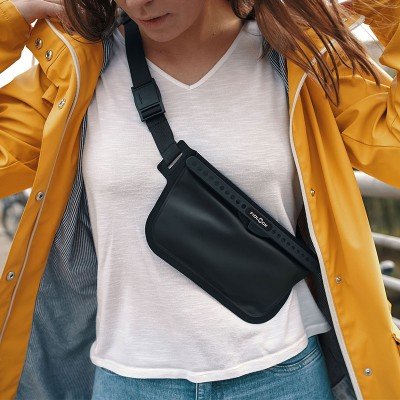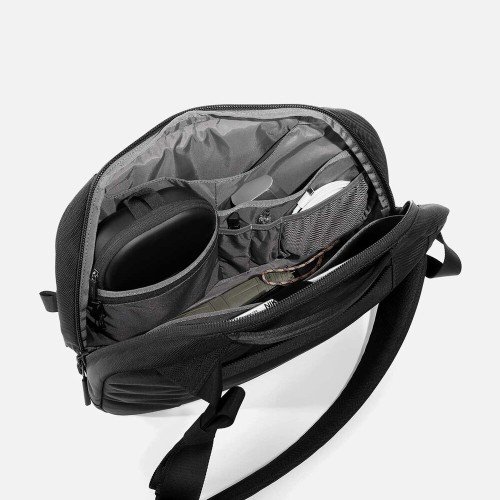
I. Introduction
Sling bags are a type of shoulder bag that is designed to be worn across the body, with the strap draped diagonally over the chest and the bag resting on the lower back or hip. They typically have a single strap that is adjustable to fit different body sizes and shapes, and they come in a variety of shapes and sizes to accommodate different needs and styles. Sling bags are popular among commuters and travelers who need to carry essential items while keeping their hands free, as well as among outdoor enthusiasts who need a lightweight and convenient way to carry gear on the go.
However, improper design and functionality of these bags can lead to shoulder strain and discomfort. Therefore, it is important to consider the design and functionality features of a sling bag to minimize shoulder strain. This includes factors such as the size and weight of the bag, the distribution of weight, padding and support for the shoulders and back, and the use of adjustable straps. By paying attention to these important design and functionality features, importers can ensure that their sling bags are comfortable and safe for users to wear, reducing the risk of shoulder strain and injury.
II. Understanding Shoulder Strain

A. Causes and Symptoms of Shoulder Strain from Sling Bags
The main cause of shoulder strain from sling bags is the uneven distribution of weight on one shoulder, which can result in muscle tension, pain, and stiffness. Over time, this can lead to more serious conditions such as rotator cuff injuries and frozen shoulders. Symptoms of shoulder strain from sling bags include pain or discomfort in the shoulder, neck, or upper back, as well as reduced range of motion and weakness in the affected shoulder. It is important to address these symptoms early on and take steps to prevent further strain.
B. Impact of Design and Functionality on Shoulder Strain
Improper design and functionality can lead to shoulder strain and discomfort. The impact of design and functionality on shoulder strain cannot be overlooked. A poorly designed sling bag can put unnecessary pressure on the shoulders and neck, leading to muscle fatigue, pain, and discomfort. On the other hand, a well-designed sling bag with the right functionality features can distribute weight evenly and reduce the risk of shoulder strain. Therefore, it is crucial to consider the design and functionality of sling bags when choosing one to avoid shoulder strain.
III. Best Design Features for Shoulder Strain Prevention

A. Padded Shoulder Straps
These straps distribute the weight of the bag evenly across the shoulders, reducing pressure points and minimizing strain. The padding can be made from a variety of materials, such as foam or gel, and should be comfortable and breathable. Adjustable padded shoulder straps are also important, as they allow for a customized fit and can be adjusted depending on the weight of the bag and the wearer’s body type.
B. Adjustable Strap Length
Being able to adjust the length of the strap allows for a more comfortable fit for individuals of different heights and body types. This ensures that the weight of the bag is distributed evenly across the back and shoulders, reducing the risk of strain on any one area. It also allows for flexibility in how the bag is worn, such as being able to switch between wearing it across the chest or back, depending on the individual’s comfort and preference. Overall, having an adjustable strap length is an essential feature in designing sling bags that are ergonomic and comfortable to wear.
C. Ergonomic Design and Weight Distribution
A well-designed sling bag will distribute weight evenly across the shoulders and back, reducing the pressure on any one area. Look for bags with wide, contoured shoulder straps and back panels that conform to the natural shape of the body. Additionally, some bags may have additional straps or support systems that help keep the bag close to the body and prevent it from swinging around, which can also contribute to shoulder strain. Overall, an ergonomic design that prioritizes weight distribution and comfort can greatly reduce the risk of shoulder strain when using a sling bag.
D. Breathable and Ventilated Back Panels
These panels help to increase airflow and reduce sweating, which can contribute to discomfort and irritation on the shoulders and back. By promoting better ventilation and breathability, sling bags with these features can help to keep users feeling cool and comfortable, even during extended periods of use. Additionally, some breathable back panels also feature moisture-wicking materials, which help to keep the user’s skin dry and reduce the risk of skin irritation or chafing.
IV. Best Functionality Features for Shoulder Strain Prevention

A. Multiple Compartments for Even Weight Distribution
By having several compartments, items can be separated and organized according to their weight and size. This ensures that the weight of the bag is evenly distributed across the body, preventing one shoulder from bearing the brunt of the weight. Additionally, having multiple compartments also makes it easier to access items quickly without having to dig through a single large compartment, which can also cause shoulder strain. Therefore, having multiple compartments is an important functional feature to consider when looking for a sling bag that minimizes shoulder strain.
B. Easy Access and Organization Features
Easy access and organization features in sling bags can help prevent shoulder strain by allowing for quick and efficient access to items without the need for extensive rummaging. Some common easy access and organization features include front pockets, side pockets, and designated compartments for laptops or other electronic devices. Additionally, the ability to easily organize items within the bag can prevent overpacking and uneven weight distribution, which can contribute to shoulder strain. Sling bags with internal dividers, mesh pockets, and compression straps can help keep items in place and evenly distributed, reducing the likelihood of shoulder strain.
C. Lightweight and Durable Materials
Heavy materials add unnecessary weight to the bag and may cause additional strain on the shoulders. On the other hand, durable materials ensure that the bag can withstand regular use and wear and tear without needing to be replaced frequently. Materials such as nylon, polyester, and canvas are popular choices for sling bags due to their durability and lightweight properties. Additionally, materials that are water-resistant or waterproof can protect the contents of the bag in case of unexpected weather conditions.
D. Secure Closure Systems
The closure system of a sling bag should be secure and easy to use, while also providing quick access to the contents inside. One option is a zipper closure, which can be secured with a lock or a clasp to prevent theft. Another option is a magnetic closure, which is easy to open and close but still provides a secure seal. The buckle closure is also a popular option for sling bags, providing a more traditional look and feel while still offering secure closure. Whatever closure system is chosen, it should be sturdy and durable to ensure the safety of the items inside the bag.
V. Importance of Proper Sizing and Fit

A. Proper Sizing for Body Proportions
A sling bag that is too small or too large for a person’s body can cause discomfort and strain on the shoulders. It is essential to consider the bag’s dimensions and the wearer’s body proportions to ensure a proper fit. The length of the strap, the height of the bag, and the width of the straps should all be taken into account to find the ideal size for the individual.
B. Customization Options for Individual Fit
Customization options for an individual fit refer to the ability to adjust the bag’s fit and features according to the user’s preferences and body type. This can include adjustable straps, modular components, and interchangeable parts to create a customized and comfortable fit for the user. By providing customization options, the sling bag can better accommodate different body types and preferences, reducing the risk of shoulder strain and discomfort.
VII. Conclusion
In conclusion, shoulder strain caused by sling bags can be a common and debilitating issue for many people. However, with careful consideration of design and functionality features, it is possible to prevent and minimize this discomfort.
Discover our diverse range of sling bags! Don’t worry about importing the wrong ones. Simply fill out the form on the right and receive expert wholesale advice from our team. Trust us to help elevate your business.

